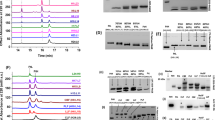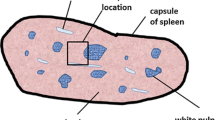Summary
The distribution of ferritin antigenicity in control and iron-loaded rat hepatocytes was investigated with an immunogold-ferritin antibody technique. Antibody to horse spleen ferritin showed immunoreactivity as determined by dot blotting with immunogold/silver staining with purified rat liver ferritin but not with rat haemosiderin. The initial site of ferritin degradation was studied by analysing the density of gold labelling in the cytosol and lysosomes in combination with pre-embedding acid phosphatase cytochemistry.
Immunoreactive ferritin was present in the cytosol, cytosolic clusters and lysosomes of normal hepatocytes. After iron-loading, the labelling density increased over tenfold in parenchymal cell cytosol with a smaller increase in Kupffer cells. Ferritin clusters contained substantially more immunoreactive ferritin than equivalent areas of lysosomes or cytosol. Analysis of the labelling density in hepatocyte lysosomes showed that, despite a striking increase in iron content, one-quarter of the lysosomes showed less immunolabelled ferritin than the cytosol. The existence of a wide range of ferritin labelling densities in the lysosomes with a large proportion unlabelled suggests that the ferritin protein shell is not degraded at a significant rate either in the cytosol or in clusters but only after incorporation into lysosomes.
Similar content being viewed by others
References
Bacon, B. R., Tavill, A. S., Brittenham, G. M., Park, C. H. &Recknagel, R. O. (1983) Hepatic lipid peroxidationin vivo in rats with chronic iron overload.J. Clin. Invest. 71, 429–39.
Bridges, K. R. (1987) Ascorbic acid inhibits lysosomal autophagy of ferritin.J. Biol. Chem. 262, 14773–8.
Cham, B. E. Roeser, H. P., Nikles, A. &Ridgway, K. (1985) A procedure for the purification of ferritin from human liver by heating a methanol-treated homogenate.Anal. Biochem. 151, 561–5.
Dulmann, J., Wulfhekel, U. &Hausman, K. (1977) Differences between Kupffer cells and endothelial cells of human liver iron storage and release under normal conditions, after i.v. iron administration and in iron overload. InKupffer Cells and other Liver Sinusoidal Cells (edited byWisse, E. &Knook, D. D. L.), pp. 233–41. Amsterdam: Elsevier.
Fahimi, H. D. (1967) Perfusion and immersion fixation of rat liver with glutaraldehyde.Lab. Invest. 16, 736–50.
Fischbach, F. A., Gregory, D. W., Harrison, P. M., Hoy, T. G. &William, J. M. (1971) On the structure of haemosiderin and its relation to ferritin.J. Ultrastruct. Res. 37, 495–503.
Hulstaert, C. E., Kalichana, D. &Hardonk, M. J. (1983) Cytochemical demonstration of phosphatases in the rat liver by acerium based method in combination with OsO4 and potassium ferrocyanide post fixation.Histochemistry 78, 71–9.
Iancu, T. C. (1983) Iron overload.Molec. Aspect. Med. 6, 1–100.
Iancu, T. C., Landing, B. H. &Neustein, H. B. (1977) Pathogenetic mechanisms in hepatic cirrhosis of thalassemia major: light and electron microscopic studies.Pathol. Ann. 12, 171–200.
Iancu, T. C., Ward, R. J. &Peters, T. J. (1987) Ultrastructural observations in the carbonyl iron-fed rat, an animal model for hemochromatosis.Virchows Arch. B 53, 208–17.
Kellenberger, E., Durrenberger, M., Villiger, W., Carlemalm, E. &Wurtz, M. (1987) The efficiency of immunolabel on Lowicryl sections compared to theoretical predictions.J. Histochem. Cytochem. 35, 959–69.
Le Sage, G. D., Kost, L. J., Barham, S. S. &La Russo, N. F. (1986) Bilary excretion of iron from hepatocyte lysosomes in the rat.J. Clin. Invest. 77, 90–7.
Louvard, D., Reggio, H. &Warren, G. (1982) Antibodies to the Golgi complex and the rough endoplasmic reticulum.J. Cell Biol. 92, 92–107.
Moeremans, M., Daneels, G., Van Dijck, A., Langanger, G. &De Mey, J. (1984) Sensitive visualization of antigen-antibody reactions in dot and blot immune overlay assays with immunogold and immunogold/silver staining.J. Immunol. Methods 74, 353–60.
Novikoff, A. B. &Novikoff, P. M. (1977) Cytochemical contribution to differentiating GERL from the Golgi apparatus.Histochem. J. 9, 525–51.
O'Connell, M. J., Baum, H. &Peters, T. J. (1986a) Haemosiderin-like properties of free-radical modified ferritin.Biochem. J. 240, 297–300.
O'Connell, M. J., Ward, R. J., Baum, H. &Peters, T. J. (1986b)In vitro andin vivo studies on the availability of iron from storage proteins to stimulate membrane lipid peroxidation. InFree Radicals, Cell Damage and Disease (edited byEvans, C. R.). London: Richelieu Press.
O'Connell, M. J., Ward, R. J., Baum, H. &Peters, T. J. (1987) Iron-overload, lysosomes and free radicals. InCells, Membrane and Disease Including Renal (edited byReid, E., Cook, G. M. W. &Luzio, J. P.), pp. 109–12. London: Plenum Press.
Richter, G. W. (1978) The iron-loaded cell—The cytopathology of iron storage.Amer. J. Pathol. 91, 363–96.
Richter, G. W. (1984) Studies of iron overload: rat liver siderosome ferritin.Lab. Invest. 50, 26–35.
Richter, G. W. (1986) Studies of iron overload: lysosomal proteolysis of rat liver ferritin.Pathol. Res. Pract. 181, 159–67.
Roth, J., Bendayan, M., Carlemalm, E., Villiger, W. &Garavito, M. (1981) Enhancement of structural preservation and immunocytochemical staining in low temperature embedded pancreatic tissue.J. Histochem. Cytochem. 29, 663–71.
Sindram, J. W. &Cleton-Soeteman, M. I. (1986) InThe Human Liver in Iron Overload, pp. 273. Holland: ICG Printing.
Van De Sluis, P. J. &Boer, G. J. (1986) The relevance of various tests for the study of specificity in immunocytochemical staining. A review.Cell Biochem. Function 4, 1–17.
Veenhius, M., Van Dijken, J. P. &Harder, W. (1980) A new method for the cytochemical demonstration of phosphatase activities in yeasts based on the use of cerous ions.FEMS Microbiol. Lett. 9, 285–91.
Weir, M. P., Gibson, J. F. &Peters, T. J. (1984) Biochemical studies on the isolation and characterization of human spleen haemosiderin.Biochem. J. 223, 31–8.
Williams, B. L. &Wilson, K. (1983)Principles and Techniques of Practical Biochemistry, 2nd edn. London: Edward Arnold.
Author information
Authors and Affiliations
Rights and permissions
About this article
Cite this article
Cooper, P.J., Iancu, T.C., Ward, R.J. et al. Quantitative analysis of immunogold labelling for ferritin in liver from control and iron-overloaded rats. Histochem J 20, 499–509 (1988). https://doi.org/10.1007/BF01002648
Received:
Revised:
Issue Date:
DOI: https://doi.org/10.1007/BF01002648




